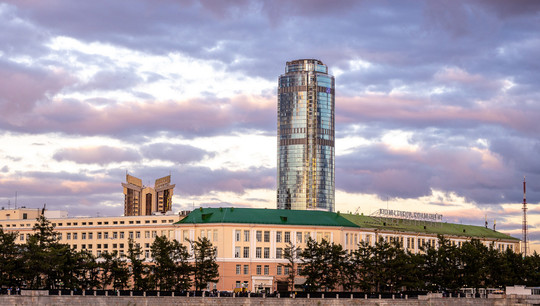Ural Federal University: Airship Docking Station and a District for Scientists Planned to Be Built in Ekaterinburg
Ekaterinburg could have not only the second metro line, but also a Soviet skyscraper, an airship docking station, a district for scientists, and many other large-scale projects. Ksenia Pimenova, a researcher at the Ekaterinburg History Museum and a Junior Researcher at the Laboratory of Digital Technologies in Historical and Cultural Research at UrFU, spoke about “zombies,” long-term construction projects, and unrealized urban planning.
GIS-map for “visible” history”
With colleagues in the laboratory we are collecting information about unrealized urban planning projects of the industrialization era in the Greater Urals territory. No one has ever done this systematically. Now we have information on 39 projects and are working on creating a publicly available interactive GIS map visualizing these plans. In this way we want to make this history visible,” Ksenia Pimenova announced the historic project.
Foreign researchers studying the phenomenon of lack of project realization have proposed the terms “shelf” or “zombie projects” to describe similar projects.”
These are ambitious but unrealized plans. Once conceived, they keep coming back to life in various forms, influencing people’s perception of the reality. The simplest example of this influence is the emergence of urban jokes about a foreigner who supposedly spent a week underground looking for the second line of the Ekaterinburg subway,” Ksenia added.
The Metallurgist’s Waterway
Perhaps the most famous Urals shelf project is the creation of a canal connecting the Volga and Ob river basins. The idea of a navigable transural waterway was born at the turn of the 19th and 20th centuries and was intended to shorten the transportation time of the products of the Urals iron and steel works to the western markets.
“Another incarnation of the project is associated with the era of Soviet industrialization. It was the time when there was a need to transport Kuzbass mineral fuel to the Urals machine-building and metallurgical plants, and in the opposite direction – finished products. However, the ambitious plans were not realized. The main reason for this was the lack of funding and the extremely long and technologically complex process of project implementation,” explains Ksenia Pimenova.
Districts for scientists and specialists
The Soviet Union continued to think in terms of megaprojects in the postwar period. In 1971, the Ural Branch of the Russian Academy of Sciences was reorganized into the Ural Scientific Center (USC). New scientific departments joined the USC, and a significant part of the funds received by the project was used to move the buildings of scientific institutes to the southwest of the city, to the area of the old Gorelovsky settlement. The Sverdlovsk “Science City” of the USC was to have all the necessary infrastructure for a comfortable life for scientists and their families – housing, kindergartens, schools, and shops.
“However, only a few of the half dozen institutes – geophysics, metallurgy, electrophysics, thermophysics, geology and geochemistry – have so far been housed in the area. The city of scientists was not built to the planned extent. The realization of the project was suspended for a prosaic reason: the financing of science was not a priority in the 1990s. The scientific centers are still territorially separated – some of them are located in Vtuzgorodok, others in the USC,” says Ksenia Pimenova.
Another unrealized project of the 1930s was the construction of constructivist Gospromural houses, which largely determined the architectural appearance of the center of Ekaterinburg. A huge area – 11 blocks in the square of the squares of the streets Mamin-Sibiryak – Lenin – Vostochnaya – Malyshev – was to be built. However, the Urals region, the center of which was Sverdlovsk, was dissolved in 1934.
“Construction financing was suspended when only one residential district was built and the development of the second one began, a model school was built, a builders’ club at the intersection of Lunacharskogo and Lenina Streets, and the House of Industry – “office space” for specialists of the companies paying for the construction. It was planned to build a skyscraper to serve as a mooring mast for airships. In the 1930s Sverdlovsk was conceived as one of the hubs of the All-Union transport megaproject,” adds Ksenia Pimenova.
Himmash prehistory
Another unrealized industrial and town-planning project was the construction of the Ural Chemical Apparatus Plant and the associated social city on the southern outskirts of Sverdlovsk. The plant was included in the first five-year plan in 1930, and construction began at the end of the plan, coinciding with the crisis of 1930-1931, which forced the leaders of industrialization to reconsider their ambitious plans. As a result, funds were reallocated to higher priority projects that were nearing completion.
“In 1933 the construction was frozen twice. In 1934 the construction of an airship docking station was started at Uralhimmashstroy, a symbolically higher priority project, which in fact ‘parasitized’ the construction of the plant, drawing funds and manpower to itself. The construction had to be stopped again. In 1937 construction was resumed under the name of the Ural Heavy Chemical Engineering Plant. However, before the war not a single production building appeared on the territory of Uralhimmashmashstroy. Despite the fact that the construction was financed and carried out throughout the 1930s, the plant did not produce its first batch of products until 1942, when production at the Uralhimmashstroy site began at the Bolshevik plant that had been evacuated from Kiev,” explains Ksenia Pimenova.
The modern Ural Chemical Engineering Plant and the Himmash microdistrict, the direct successor to the unrealized plant, were developed according to new post-war plans that have much in common with the unrealized projects of the 1930s.

